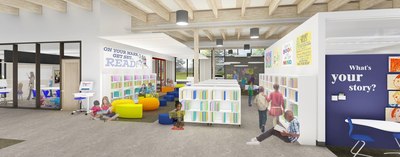|
Subscribe / Renew |
|
|
Contact Us |
|
| ► Subscribe to our Free Weekly Newsletter | |
| home | Welcome, sign in or click here to subscribe. | login |
Construction
| |
 |
August 1, 2019
Can a building help kids cultivate personal relationships?


By STEPHEN
BLACK &
AARON
WINSTON |
In the past, school design has focused on the pure programmatic requirements of the school — concerned only with building the requisite number of classrooms and spaces.
Savvy school districts now know that the social-emotional development of a child is key to the child’s ability to learn.
Social-emotional learning provides students with a way to understand and manage their emotions, how to set and achieve positive goals, how to feel and show empathy for others, how to establish and maintain positive relationships and how to make responsible decisions.
The first day of kindergarten is a day both loved and dreaded by most parents. Many kids make it through the day with no serious issues.
Some kids however see school as a scary place, full of strangers with whom they have no relationship which can lead to disruption or acting out by students.
Schools that focus on the social-emotional learning of a child understand that building a strong relationship with kids help them to see school as a safe and welcoming place full of friends — a place where they are comfortable enough to learn.
Schools in which social-emotional learning drives curriculum, relationship-building and other interactions create a strong sense of belonging and support for students in key areas.
With that type of supportive environment in mind, one of the key questions for us as we began to design Birney Elementary School in Tacoma was this: How can the design of a new school help cultivate these types of personal relationships?
Social-emotional learning is a central component in a district-wide program in Tacoma called The Whole Child Initiative. This holistic approach to learning is based on research that proves a dedicated support network strengthens students’ social and emotional skills and enables them to confidently discover their passions and interests in life.
The design of the new Birney Elementary cultivates a dedicated support network around students by welcoming families and the community in and providing a diversity of spaces for engaging in the daily life of the school.
Relationships between students
Building relationships with other students can be easy if settings for social interaction are provided in the school. These spaces can be as simple as alcoves in the corridor or a separate small room in the building.
At Birney, we added Buddy Benches in the main circulation area. These colorful alcoves provide a slight increase in privacy to encourage one-on-one conversations without separating students from the hustle and bustle.
Students also have access to an open library, which provides settings for a variety of experiences, from cozy individual seating to small-group activity and large-group reading spaces.
Birney’s classrooms are organized into clusters, with shared activity areas and small-group rooms, all visually connected to form a learning neighborhood. Just outside each neighborhood are areas that allow students to gather comfortably before and after school.
These spaces are also used by small groups for practicing self-management during collaborative work. Each learning neighborhood has a designated art gallery to foster a sense of belonging by allowing students to express their identity and creativity.
Students also need space within the classroom to concentrate on tasks or take a moment to refocus themselves and their emotions. At Birney, each classroom features a small Focus Space for students that looks out to nature with comfortable, adjustable seating.
Choice and flexibility allow students to create spaces that are most conducive to learning for them, when they need it, without being asked to leave class.
Student and adult relationships
Research shows that the relationship built with a teacher can be the most fruitful for a student. Relationships with multiple adults are even more beneficial. These relationships with teachers and specialists encourage students to trust the information being taught and gives students someone to consult for advice on issues such as how to resolve conflicts.
Birney’s Peace Rooms provide space for teachers and support specialists to meet with students to discuss conflicts and develop solutions.
The purpose is to discuss the cause of the conflict and how students could have reacted differently. This process, and space to support it, helps build empathy and problem-solving skills. These rooms should be positioned within the learning neighborhoods to be visible from the classroom.
This arrangement supports social-emotional learning and allows other student support services to be provided within the neighborhoods throughout the day. The principal and counselor offices are located in “the heart of action” rather than in a back hallway. They are provided with comfortable soft seating and large windows to be visible and create a sense of welcome rather than discipline – encouraging positive relationships.
Parents and partners
The design for Birney includes a welcoming Family Connection Center, hosted by a family liaison, for parents to meet with teachers, other parents and community partners.
The FCC fosters relationships with parents that break down social barriers and help them feel a part of the school community. In the FCC, parents learn how to model at home the social emotional lessons their children are learning in school.
By being thoughtful about providing school settings that support social-emotional learning, we can help students be more self-aware, practice self-management, have more social awareness, develop relationship skills and be responsible decision makers.
These skills boost students’ success in school and in life and can transform stress and anxiety into happy and nurturing experiences for children.
Stephen Black is a project manager and Aaron Winston is a project architect with McGranahan Architects.
Other Stories:
- At successful schools, learning happens everywhere
- As classrooms evolve to meet changing needs, the furniture should too
- How safety by design makes school projects safer from start to finish, and beyond
- Reducing K-12 carbon footprints through reuse
- Tacoma takes a chance on progressive design-build
- New middle school furthers Seattle Academy’s urban evolution
- When it comes to renovations, seeing is believing
- A designer’s day as a kindergartner
- Tsunami-safe elementary a model for coastal communities
- WA public schools: Top 10 project awards for 2019
- Concrete systems help schools achieve net-zero goals
- Tacoma school has flexible spaces that invite learning, community



